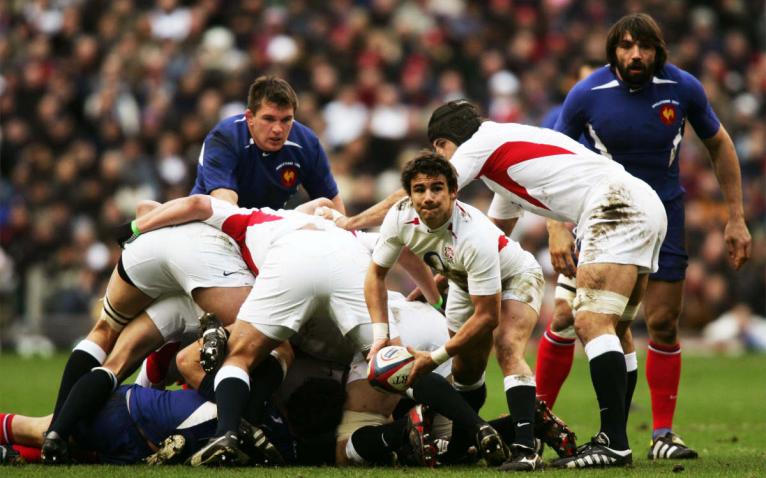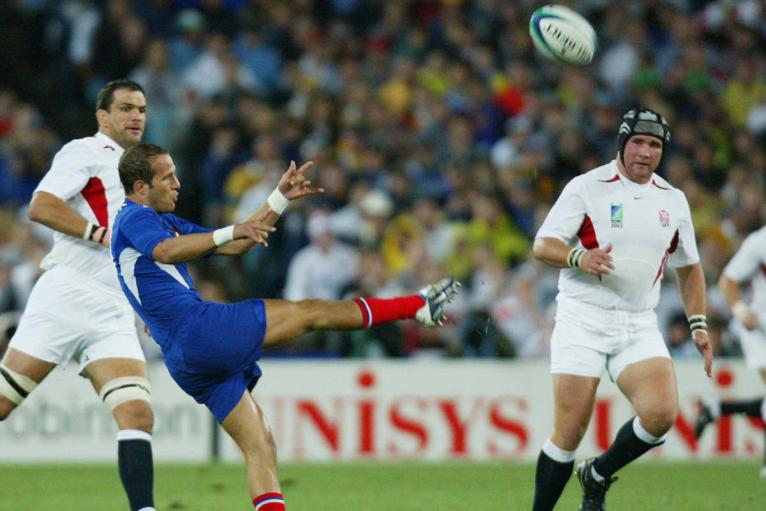I’m not naïve enough to pretend there are no issues with rugby. The Premiership just lost three teams in a season and grass roots rugby in Britain continues to struggle, but for all the naysayers predicting the end is nigh, there are reasons to be cheerful.
World Rugby research shows that the game is growing, powered by women, children, and previously untapped markets. The World Cup will look to build on that even further and it’s well placed to. Regardless of what is happening off the pitch, there is one thing we can say for certain, rugby on the pitch has never looked better.
Let’s start with the psychological elephant in the room. Everything was better in the past. You know it, I know it, the entire premise of Facebook’s ongoing existence is based on it. We were thinner, had more hair, the summers lasted forever, and, 99s actually cost 99p. Everything was better. Everything that is, apart from rugby.
In the 2005 Six Nations, England made more carries than any other side according to Opta – 502 across the tournament. In 2023, France made the fewest carries of any side – 558. Ireland barely made 300 carries, 60 a match. Even the most kick-heavy teams – the 2021-2022 Leicester Tigers for example, would struggle to sink to lower than 60 carries a match.
Hop on YouTube and you can watch England v France from that Six Nations. I’m three rucks in, two to England and one to France, 21 attacking players have been committed to those rucks. A few more minutes in and neither team has strung together more than four phases before they kick it away. Largely that’s because they’re totally devoid of attacking options after a couple of rucks where everyone is invited to pile-on. There are points where there are five people in the attacking line and none of them are more than 15m from the ruck. As attack’s go, it’s not expansive.
By half-time it’s been very stop-start, devoid of tactical interest, and first phase aside, neither team has passed the ball wide. The ruck is a pain point. Despite the massive amount of resources teams chuck at it, nobody is getting quick ball. When the ball does come, it’s not laid on a platter for the scrum-half, it squirts out the back and one of the few players in an attacking position has to dive on it and start the whole exercise again. After a few retained rucks the ball is either lost or the defending side is penalised.

An hour previously, I was watching Aix-en-Provence beating Nevers in France’s ProD2. Two teams who would be ranked no higher than 50th in Europe. It’s a beautiful exhibition of running rugby with forwards interlinking and teams spreading the ball right the way across the pitch. Rucks are recycled quickly and defences have to account for a plethora of weapons. Neither team is particularly flamboyant in their playing style. This is essentially ‘normal’ rugby in 2023. By any measure, beyond nostalgia, it’s a sensationally better example of the sport.
Given that you are reading this, it’s likely that you watch rugby all year round. The league gives way to the Autumn Nations Series, which gives way to Europe, which gives way to the Six Nations, which gives way to the end of the season, which gives way to the summer Tests, and we repeat again. With that constant diet of rugby, it’s impossible to tell the changes that take place.
Modern rugby is a stunning masterpiece compared to some of the matches we had to put up with 20 or so years ago.
Rugby has been on a constant path of improvement. Skills that were once deemed extraordinary and worthy of significant comment are now commonplace. In 1954 Roger Bannister famously ran the mile in under four minutes. That record stood for less than two months before Australian John Landy beat it by 1.4 seconds. Ten years later it was more than five seconds quicker. Now, 1,497 men have run a sub four minute mile in competition.
Rugby is on its own four minute mile quest. When Sonny Bill Williams began offloading out the back of his hand it was an extraordinary feat of skill, deserving of highlight reels and making Williams a household name. Now it happens almost every game with little more than a raised eyebrow of appreciation.
When Williams did it first he had a competitive advantage. But fellow pros could see it was an attacking weapon and worked on it. Kids at the time were doing it and had perfected it by the time they made their professional debuts. It’s the same with all skills in the game. They have all continued on a trajectory from noteworthy to commonplace and the cycle begins again as a new noteworthy skill emerges.

Modern rugby is a stunning masterpiece compared to some of the matches we had to put up with 20 or so years ago. But those matches have enjoyed the filter of time. The boring ones are left unremembered while the great ones linger in the memory. If we see anything from those games it will be brief highlights showing 80 minutes of very ordinary rugby condensed into the best 90 seconds. It doesn’t take a great logical leap to assume all 80 minutes were like those 90 seconds.
Meanwhile, we see all 80 minutes of modern games – every box kick in HD. The best games of recent years; France v New Zealand in 2021, Ireland v France in 2023, Leinster v La Rochelle in 2023 haven’t had decades of mystique and legend added to them. It’s hard to believe that we might have been lucky enough to have seen one of rugby’s greatest games rather than have heard about it from a parent in reverential tones.
What about rugby now though, it’s not perfect is it? Of course it isn’t. The most moaned about elements are the caterpillar ruck and the time it takes to set a scrum. I admit that they’re hard parts of the game to love. But watch the dull ruck fests of the early 2000s and you’d be crying out for someone to spend 10 seconds waiting to hoof a ball from the back of an elongated ruck. Scrums, I grant you, probably were better back in the day. They were set quicker and weren’t used as penalty vending machines.
The handling ability of the forwards in the class of 2023 is, almost across the board, better than the backs of the early 2000s.
Both they and lineouts were far more numerous though. At the 2003 World Cup there were 22 scrums per game and 34 lineouts according to Opta. By 2019 those numbers had dropped to 14 and 25 and have dropped further still. Almost all the time savings per scrum are eaten up by the fact there were more scrums in total.
Kicks have also dropped, despite what you may think. The early 2000s were obscenely kick heavy. At the 2003 World Cup there were 52 kicks per game according to World Rugby’s stats. That had fallen to 39 by 2015 and the ball in play time had increased slightly, it has since increased another 10%. Not only were there more kicks, the fact the ball was in play for less time meant that there were more kicks per minute of play. Why anybody should think there is more kicking now is deserving of a serious sociological study.

The 2023 Rugby World Cup will be the greatest collection of rugby talent we have ever seen. I’m not just talking about the superhumans; Antoine Dupont, Eben Etzebeth, Levani Botia, Josh Van der Flier, I am talking about everybody who will take the field. The handling ability of the forwards in the class of 2023 is, almost across the board, better than the backs of the early 2000s. The speed and dynamism of the forwards is beyond anything that we’ve seen. The vision of the halfbacks has never been reached before. The kicking ability is more accurate than it has ever been.
At the time, 2005 was the best rugby had ever been and that progress was part of a continuum which has led to where we are today. But that hasn’t stopped. 2023 is the best it has ever been but in 2041 we will hopefully be able to look back at this World Cup and laugh at the fact that we thought it was impressive.
It’s tempting to think rugby was better when we were younger, after all everything else was, but it’s not true. You are living in the golden age of rugby and on the cusp of the greatest tournament at the, current, height of rugby’s skill level.


Not sure what this guy is smoking. Rugby is dying as evidenced up north with bankrupt clubs and in the south in Australia it's nothing but a niche sport. Then NZ, the game is on its knees. A super rugby finals match got under 10k, the all blacks don't sell out and people are more interested in the Wahs than the world cup
The game is an absolute shambles. Constant tmo interruptions, fake injuries, never ending subs, 2nd halves that seem to go on longer than cricket test matches.
Dunno about all that, its a glass all empty.
Another article on here was explaining how the All Blacks are getting more money than ever, it might just be a matter of spreading that better. NZs I am in contact with are super stoked about the world cup.
And the game itself is great, don't know what you are on about. Who care if a sub comes on, it takes a few seconds.
Reset scrums are a bit painful, but that is only in about 5% of the game.
The TMO for head shots is something we just have to through. Players need to be hyper carefull about that, even if it sometimes means giving away the collision and potentialy points. Until that moment they will be penalized with cards.
I agree that the TMOs for try scoring takes a bit of the spontaneous joy out of it. But in the dissillusionment of fans and teams if bad calls are made (which would be inevitable without TMO checks) are an even worse penalty to take. And they are constantly looking to improve the protocol and speed it up.
I haven't been as excited in a long time, can't wait for tomorrow's game. I guess you won't be watching since it's bound to be so terrible.
Absolutely. As I was saying…
I think that if you look at the way the southern hemisphere teams (particularly Australia ans NZ) played in the past you’ll see that positive and attacking fast rugby was always their forte. NH teams have caught up (and more and more tried to emulate that style of play with varying degrees of success) so presumably that is what the writer is alluding to here. The sad part is that rule changes and the dominance of the NH idea of playing a technical forward dominated game has become the norm in recent times…you only need to see the length of the game (beyond 80 mins) and time in play stats to see where things are headed. Rugby is in danger or being a bore-fest. Hopefully this style and attitude will not prevail. Have a look at how the Fijians play. Always with endeavour and a smile on their face. Not the gruff pedantic muscular behemoths that trudge from one scrum to another. Sad but true.
Refereeing was the big difference. Minor contacts went unheeded, no video, fast scrummaging. Far less time off was therefore lost.
Skills have grown, but yes, I have stronger memories back in time than recently. I’m probably biased….
Skills are definitely better now but stopages are definitely worse. I think a big part of that is the safety factor.
“stats” 😂
i wasn’t alive during the 70s but whenever i go back and watch a classic match i’m dumbstruck by the flow, the skill and the entertainment. rugby has never been worse than it is right now. most of my diehard friends refuse to watch games live so that they can skip through all the stoppages. your stats are meaningless.
I'm also dumbstruck by the flow and skill of older matches. More specifically, the complete lack of it.
I'm watching NZ vs Lions in 1977, (think 2nd test?) that you recommended.
Looks to me a bit of an unholy mess! :D :D
- amazingly fast scrum (and lineout) sets (but scrums and lineouts a giant mess)
- very fast penalty kicks at posts
- thankfully scrums and lineouts go fast because there are so so many.
- a looooooot of kicking.
- a massive mess ruck time. Many (most) possentions just end in 1 or 2 phases in
a ruck
- a lot of penalties (and hard to understand the offsides)
- very little free running, when it happens it's mostly of turnover ball direclty from a set piece.
Anyway, there are some things to learn, mainly around time wasting before set pieces. In the modern game, I don't see why they can't penalize teams for not being at the scrum or lineout faster.
But in general I much prefer a modern game!
Can you recommend a game I can look up? Maybe on that common video sharing platform? I watched games as a kid in the 80s but probably the memory has faded a bit :)
It was certainly more entertaining in the past.